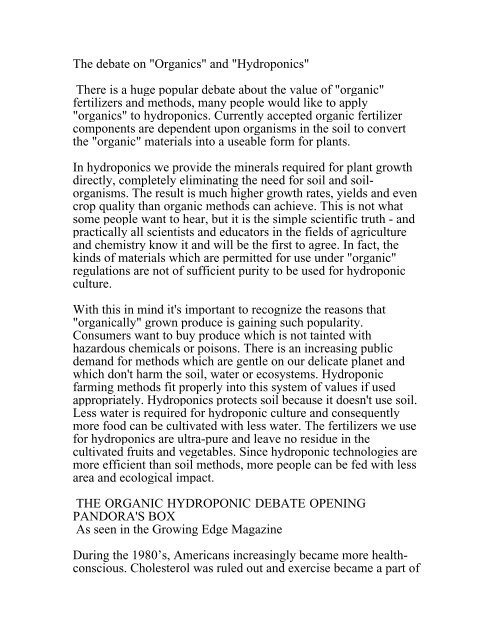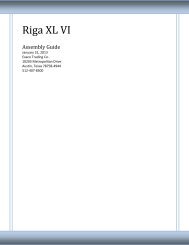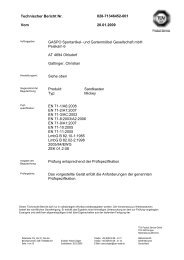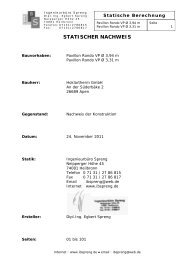The debate on "Organics" and "Hydroponics" There is a ... - Exaco
The debate on "Organics" and "Hydroponics" There is a ... - Exaco
The debate on "Organics" and "Hydroponics" There is a ... - Exaco
You also want an ePaper? Increase the reach of your titles
YUMPU automatically turns print PDFs into web optimized ePapers that Google loves.
<str<strong>on</strong>g>The</str<strong>on</strong>g> <str<strong>on</strong>g>debate</str<strong>on</strong>g> <strong>on</strong> "Organics" <strong>and</strong> "Hydrop<strong>on</strong>ics"<br />
<str<strong>on</strong>g>The</str<strong>on</strong>g>re <strong>is</strong> a huge popular <str<strong>on</strong>g>debate</str<strong>on</strong>g> about the value of "organic"<br />
fertilizers <strong>and</strong> methods, many people would like to apply<br />
"organics" to hydrop<strong>on</strong>ics. Currently accepted organic fertilizer<br />
comp<strong>on</strong>ents are dependent up<strong>on</strong> organ<strong>is</strong>ms in the soil to c<strong>on</strong>vert<br />
the "organic" materials into a useable form for plants.<br />
In hydrop<strong>on</strong>ics we provide the minerals required for plant growth<br />
directly, completely eliminating the need for soil <strong>and</strong> soil-<br />
organ<strong>is</strong>ms. <str<strong>on</strong>g>The</str<strong>on</strong>g> result <strong>is</strong> much higher growth rates, yields <strong>and</strong> even<br />
crop quality than organic methods can achieve. Th<strong>is</strong> <strong>is</strong> not what<br />
some people want to hear, but it <strong>is</strong> the simple scientific truth - <strong>and</strong><br />
practically all scient<strong>is</strong>ts <strong>and</strong> educators in the fields of agriculture<br />
<strong>and</strong> chem<strong>is</strong>try know it <strong>and</strong> will be the first to agree. In fact, the<br />
kinds of materials which are permitted for use under "organic"<br />
regulati<strong>on</strong>s are not of sufficient purity to be used for hydrop<strong>on</strong>ic<br />
culture.<br />
With th<strong>is</strong> in mind it's important to recognize the reas<strong>on</strong>s that<br />
"organically" grown produce <strong>is</strong> gaining such popularity.<br />
C<strong>on</strong>sumers want to buy produce which <strong>is</strong> not tainted with<br />
hazardous chemicals or po<strong>is</strong><strong>on</strong>s. <str<strong>on</strong>g>The</str<strong>on</strong>g>re <strong>is</strong> an increasing public<br />
dem<strong>and</strong> for methods which are gentle <strong>on</strong> our delicate planet <strong>and</strong><br />
which d<strong>on</strong>'t harm the soil, water or ecosystems. Hydrop<strong>on</strong>ic<br />
farming methods fit properly into th<strong>is</strong> system of values if used<br />
appropriately. Hydrop<strong>on</strong>ics protects soil because it doesn't use soil.<br />
Less water <strong>is</strong> required for hydrop<strong>on</strong>ic culture <strong>and</strong> c<strong>on</strong>sequently<br />
more food can be cultivated with less water. <str<strong>on</strong>g>The</str<strong>on</strong>g> fertilizers we use<br />
for hydrop<strong>on</strong>ics are ultra-pure <strong>and</strong> leave no residue in the<br />
cultivated fruits <strong>and</strong> vegetables. Since hydrop<strong>on</strong>ic technologies are<br />
more efficient than soil methods, more people can be fed with less<br />
area <strong>and</strong> ecological impact.<br />
THE ORGANIC HYDROPONIC DEBATE OPENING<br />
PANDORA'S BOX<br />
As seen in the Growing Edge Magazine<br />
During the 1980’s, Americans increasingly became more health-<br />
c<strong>on</strong>scious. Cholesterol was ruled out <strong>and</strong> exerc<strong>is</strong>e became a part of
our daily routines. Today th<strong>is</strong> still holds true, but even more so.<br />
What we put into our bodies <strong>is</strong> carefully scrutinized, even our<br />
fruits <strong>and</strong> vegetables, which has made “organic” a buzzword of the<br />
‘90s. People are buying organic skin care products, “organic<br />
shampoos” <strong>and</strong> even "organic clothing”. Everybody seems to want<br />
“organic” <strong>and</strong> hydrop<strong>on</strong>ic growers are quite aware of th<strong>is</strong>. Why,<br />
then, are there hardly any "Certified Organic hydrop<strong>on</strong>ic growers”<br />
in the United States? Many go through a great deal of trouble to<br />
grow their crops "organically," but even though they follow most<br />
guidelines, they still cannot get the recogniti<strong>on</strong> or certificati<strong>on</strong><br />
necessary to sell their produce to most restaurants or natural food<br />
stores as “organic”. What <strong>is</strong> it that <strong>is</strong> separating organic from<br />
hydrop<strong>on</strong>ic methods? Why can't these two technologies work<br />
together under today's American states' certificati<strong>on</strong> guidelines?<br />
WHAT'S ORGANIC, WHAT'S NOT?<br />
We would think that th<strong>is</strong> <strong>is</strong> an easy questi<strong>on</strong> to answer, but it <strong>is</strong>n't.<br />
In the United States there are numerous different definiti<strong>on</strong>s of<br />
"organic", many of which differ significantly. Each state has its<br />
own regulati<strong>on</strong>s for labeling produce as “organic". Additi<strong>on</strong>ally,<br />
there are 36 n<strong>on</strong>-governmental organizati<strong>on</strong>s which can certify"<br />
produce as organic. For example, California growers who w<strong>is</strong>h to<br />
sell their produce as "organic" must reg<strong>is</strong>ter with the California<br />
Department of Food <strong>and</strong> Agriculture <strong>and</strong> pass their inspecti<strong>on</strong>.<br />
However, California grower's can also obtain certificati<strong>on</strong> through<br />
the California Certified Organic Farmers (CCOF), which actually<br />
has higher st<strong>and</strong>ards for organic than the state has.<br />
<str<strong>on</strong>g>The</str<strong>on</strong>g> CCOF certificati<strong>on</strong> <strong>is</strong> opti<strong>on</strong>al, but produce with California<br />
state reg<strong>is</strong>trati<strong>on</strong> <strong>and</strong> CCOF certificati<strong>on</strong> may be offered for sale<br />
within the state as "certified organic" If the grower chooses not to<br />
seek CCOF certificati<strong>on</strong>, the produce can be offered for sale in<br />
California as "organic," but not "certified organic”. Any produce<br />
grown outside of the United States can be sold as "certified<br />
organic" in the country if <strong>on</strong>e of the 36 n<strong>on</strong>-governmental<br />
organizati<strong>on</strong>s certifies it. In fact, produce from any state can be<br />
granted certificati<strong>on</strong> from <strong>on</strong>e of the n<strong>on</strong>-governmental<br />
organizati<strong>on</strong>s, even if it does not meet the organic st<strong>and</strong>ards for the<br />
state in which it <strong>is</strong> being sold. Pretty c<strong>on</strong>fusing!
What th<strong>is</strong> all means <strong>is</strong> that the "organic" label <strong>is</strong> a matter of<br />
bureaucratic definiti<strong>on</strong>s, which can vary from state to state, <strong>and</strong><br />
country to country.<br />
In order to bring some kind of st<strong>and</strong>ard into play, the U.S.<br />
Department of Agriculture (USDA) – al<strong>on</strong>g with state government<br />
regulators, n<strong>on</strong>-governmental certifiers, c<strong>on</strong>sumers, industry<br />
interest groups, food processors <strong>and</strong> various special interest groups<br />
– <strong>is</strong> writing a federally m<strong>and</strong>ated set of "organic" st<strong>and</strong>ards. No<br />
state will be able to apply more stringent st<strong>and</strong>ards than those of<br />
the federal. Sometime th<strong>is</strong> spring, the federal st<strong>and</strong>ards will be<br />
released for a 90 day comment <strong>and</strong> review period, <strong>and</strong> by the end<br />
of 1996 or early 1997, these st<strong>and</strong>ards will become law, or<br />
"Frankenlaw"; we'll have to wait <strong>and</strong> see.<br />
<str<strong>on</strong>g>The</str<strong>on</strong>g> basic objectives of "organic" practice include the following:<br />
• Avoidance of pesticides, by use of natural pest c<strong>on</strong>trols (also<br />
applied by many hydrop<strong>on</strong>ics growers).<br />
• Caring for soil by recording nutrients <strong>and</strong> composting, <strong>and</strong><br />
• Moderati<strong>on</strong> of nutrient applicati<strong>on</strong> with reliance <strong>on</strong> the buffer<br />
acti<strong>on</strong> of humus derived from compost.<br />
Soilless hydrop<strong>on</strong>ic cultivati<strong>on</strong> moderates nutrient supply by the<br />
more exact measurements of soluble nutrient formulati<strong>on</strong>s, mixed<br />
to meet the optimum requirements of each plant species <strong>and</strong><br />
growth phase. Many c<strong>on</strong>sumers select "organic" produce,<br />
believing that th<strong>is</strong> <strong>is</strong> the <strong>on</strong>ly way to be assured of pesticide-free<br />
n<strong>on</strong>—hazardous food. While "organic" farming methods do<br />
produce crops generally superior to <strong>and</strong> safer than those grown by<br />
agri-business practices, modern hydrop<strong>on</strong>ic techniques can put<br />
forth equally safe food that in many cases offers advances in<br />
nutriti<strong>on</strong> <strong>and</strong> taste over their soil-grown “organic” counterparts.<br />
But to the c<strong>on</strong>sumer, it's the label that counts, so an increasing<br />
number of growers throughout the United States are struggling to<br />
get organic certificati<strong>on</strong> in any way, shape or form.<br />
Meanwhile, th<strong>is</strong> whole situati<strong>on</strong> poses an enormous dilemma to<br />
hydrop<strong>on</strong>ic growers who also want organic recogniti<strong>on</strong> for their<br />
produce. <str<strong>on</strong>g>The</str<strong>on</strong>g> primary problem for organic hydrop<strong>on</strong>ic growers <strong>is</strong>
in the formulati<strong>on</strong> of the soilless nutrient soluti<strong>on</strong>. A sec<strong>on</strong>dary<br />
<strong>is</strong>sue, which c<strong>on</strong>cerns the federal regulators, <strong>is</strong> in the way used<br />
hydrop<strong>on</strong>ic nutrient <strong>and</strong> media such as rockwool are d<strong>is</strong>posed of.<br />
Since "organic" <strong>is</strong> to a large extent a farming philosophy in support<br />
of a healthy envir<strong>on</strong>ment, the federal c<strong>on</strong>cern <strong>is</strong> entirely<br />
reas<strong>on</strong>able.<br />
Although the latter factor has no bearing <strong>on</strong> the quality <strong>and</strong> safety<br />
of the produce itself, the impact up<strong>on</strong> the planet <strong>is</strong> a real driving<br />
force behind the <strong>is</strong>sue of "organic" farming. If hydrop<strong>on</strong>ic growers<br />
can find a way to completely recycle exhausted water, nutrients<br />
<strong>and</strong> media, then the argument in favor of "organic-hydrop<strong>on</strong>ic<br />
certificati<strong>on</strong>" becomes much str<strong>on</strong>ger, but there's still the <strong>is</strong>sue of<br />
formulating a sat<strong>is</strong>factory organic hydrop<strong>on</strong>ic nutrient mix.<br />
Organic nutrient regulati<strong>on</strong>s prohibit the use of many mineral salts<br />
<strong>and</strong> highly refined substances, including food <strong>and</strong> pharmaceutical<br />
grade ingredients that are extremely important for successful<br />
hydrop<strong>on</strong>ic nutrient formulati<strong>on</strong>.<br />
Only unrefined minerals can be used <strong>on</strong> "organic" crops <strong>and</strong> these<br />
often d<strong>on</strong>'t d<strong>is</strong>solve well or c<strong>on</strong>tain quantities of impurities, some<br />
of which are even relatively toxic but are "natural” <strong>and</strong> therefore<br />
“okay”, according to organic st<strong>and</strong>ards. For example, mined<br />
phosphate may c<strong>on</strong>tain excessive amounts of fluoride, good for<br />
teeth in very small quantities, but harmful to humans in excess.<br />
Mined phosphate also can c<strong>on</strong>tain small amounts of radioactive<br />
elements such as radium, which releases rad<strong>on</strong>, also not good for<br />
human health. Chlorides, too, are permitted for organic cultivati<strong>on</strong><br />
but though they are naturally mined, they can be bad for both<br />
plants <strong>and</strong> soil, especially if used in excess. Some soils used by<br />
organic farmers c<strong>on</strong>tain such toxic elements as selenium, which<br />
can accumulate in the plant t<strong>is</strong>sues <strong>and</strong> produce. Amazing, <strong>is</strong>n't it?<br />
When refined, any impurities or toxicities such as those l<strong>is</strong>ted<br />
above are removed, but refined minerals make for n<strong>on</strong>-organic<br />
produce. Blood meal, b<strong>on</strong>e meal, f<strong>is</strong>h meal <strong>and</strong> manures pose<br />
almost no potential safety hazards, but they d<strong>on</strong>'t d<strong>is</strong>solve very<br />
well; they must be broken down through microbial acti<strong>on</strong> in the<br />
soil <strong>and</strong> therefore d<strong>on</strong>'t work well in hydrop<strong>on</strong>ic applicati<strong>on</strong>s.<br />
<str<strong>on</strong>g>The</str<strong>on</strong>g>re <strong>is</strong> also a problem that sometimes ar<strong>is</strong>es when using manures.
<str<strong>on</strong>g>The</str<strong>on</strong>g> Western Fertilizer H<strong>and</strong>book, an important guide for<br />
American farmers, points out that many gastro-intestinal illnesses<br />
can he traced back to manures used <strong>on</strong> organically gown crops. In<br />
the summer of 1995, a serious outbreak of salm<strong>on</strong>ella po<strong>is</strong><strong>on</strong>ing<br />
resulted from an organic cantaloupe crop growing in soil fertilized<br />
with fresh chicken manure. <str<strong>on</strong>g>The</str<strong>on</strong>g> rinds of the mel<strong>on</strong>s had become<br />
c<strong>on</strong>taminated <strong>and</strong> the bacteria caused serious intestinal illness for<br />
many c<strong>on</strong>sumers.<br />
Another point that can be made <strong>is</strong> that strict vegetarians or animal<br />
rights activ<strong>is</strong>ts may be offended by the use of blood, b<strong>on</strong>e, horn,<br />
hoof <strong>and</strong> feather meals to grow their food, but these are primary<br />
nutrient sources for organic farmers.<br />
As you can see, th<strong>is</strong> <strong>is</strong>sue Is very complex <strong>and</strong> there are many<br />
points of view. Essentially though, "organic" farming <strong>is</strong> part<br />
philosophy <strong>and</strong> part methodology, but unfortunately defined<br />
bureaucratically.<br />
WHAT'S HYDROPONIC; WHAT'S NOT?<br />
If a plant <strong>is</strong> grown without soil <strong>and</strong> with a complete nutrient<br />
soluti<strong>on</strong>, that's hydrop<strong>on</strong>ics! It can be as simple as plants glowing<br />
in s<strong>and</strong>, gravel or rockwool with a nutrient drip, or as complex as a<br />
complete waterculture system, such as NFT (Nutrient Film<br />
Technique) or aerop<strong>on</strong>ics.<br />
No matter what method you use, the key to successful<br />
hydrop<strong>on</strong>ics <strong>is</strong> nutrients. Hydrop<strong>on</strong>ic crops are ra<strong>is</strong>ed <strong>on</strong> a<br />
perfected mix of primary, sec<strong>on</strong>dary <strong>and</strong> micro-nutrients. <str<strong>on</strong>g>The</str<strong>on</strong>g><br />
formulas for different crops <strong>and</strong> envir<strong>on</strong>ments vary, but all have<br />
been defined from extensive experience with a wide variety of<br />
crops growing in many different envir<strong>on</strong>ments throughout the<br />
world. Problems may occur where water quality <strong>is</strong> poor <strong>and</strong> where<br />
envir<strong>on</strong>mental extremes of high or low temperature <strong>and</strong> humidities<br />
place stress <strong>on</strong> crops; however, when a hydrop<strong>on</strong>ic facility <strong>is</strong><br />
properly planned <strong>and</strong> installed, the resulting crops can be<br />
impressive. Data generated in Europe, Israel, Canada, Australia<br />
<strong>and</strong> the United States have defined prec<strong>is</strong>e combinati<strong>on</strong>s of<br />
minerals for a variety of crops. <str<strong>on</strong>g>The</str<strong>on</strong>g> data <strong>is</strong> so accurate that
equired elements are specified in mS (mil<strong>is</strong>iemens) <strong>and</strong> uS<br />
(microsiemens), a system of measuring by electrical c<strong>on</strong>ductivity<br />
<strong>and</strong> calculating by atomic weight.<br />
Based <strong>on</strong> these findings, the Dutch research stati<strong>on</strong> at Aalsmeer<br />
has organized nutrient soluti<strong>on</strong>s into three classes:<br />
• "A" refers to formulas that have been extensively tested <strong>and</strong> can<br />
be c<strong>on</strong>sidered reliable.<br />
• "B" signifies formulas that are fairly new but working quite<br />
well; some changes can be expected before upgrading to a class<br />
"A."<br />
• "C" formulas are experimental; significant changes can be<br />
anticipated before upgrading to class B or A.<br />
Formulas are defined for a given crop growing under different<br />
c<strong>on</strong>diti<strong>on</strong>s. For example, elements are specified for the nutrient<br />
reservoir, while a separate specificati<strong>on</strong> <strong>is</strong> made for the nutrients in<br />
the "root envir<strong>on</strong>ment" if growing media <strong>is</strong> used, particularly<br />
rockwool. <str<strong>on</strong>g>The</str<strong>on</strong>g> root envir<strong>on</strong>ment usually has higher c<strong>on</strong>centrati<strong>on</strong>s<br />
of elements since minerals will accumulate in rockwool. To test<br />
the c<strong>on</strong>centrati<strong>on</strong> within the media, the grower will squeeze some<br />
nutrient out of a sample of the media, do a basic c<strong>on</strong>ductivity <strong>and</strong><br />
pH test, <strong>and</strong> sometimes send the sample to a lab for analys<strong>is</strong>. If the<br />
c<strong>on</strong>centrati<strong>on</strong> of elements in the media r<strong>is</strong>es above the<br />
recommended limits, the grower will have to adjust the<br />
formulati<strong>on</strong> of the nutrient in the reservoir or run a rinse through<br />
the media to lower the nutrient c<strong>on</strong>centrati<strong>on</strong> within the root z<strong>on</strong>e.<br />
Another formula may be defined for n<strong>on</strong>-recirculating nutrient,<br />
also called "run-to-waste," where nutrient <strong>is</strong> sent from the reservoir<br />
<strong>on</strong> a <strong>on</strong>e-way trip through rockwool <strong>on</strong>to the ground. Th<strong>is</strong> method<br />
<strong>is</strong> falling into d<strong>is</strong>favor due to the polluti<strong>on</strong> caused by the nutrient<br />
run-off <strong>and</strong> d<strong>is</strong>carded rockwool.<br />
HYDROPONIC PRODUCE AND HEALTH<br />
In 1994 a test was comm<strong>is</strong>si<strong>on</strong>ed by an investment group to<br />
determine the vitamin <strong>and</strong> mineral c<strong>on</strong>tent of hydrop<strong>on</strong>ically<br />
grown crops in compar<strong>is</strong><strong>on</strong> to soil grown crops, both organic <strong>and</strong><br />
n<strong>on</strong>organic. Plant Research Technologies Laboratory in San Jose,
California, analyzed tomatoes <strong>and</strong> sweet peppers; those<br />
hydrop<strong>on</strong>ically grown used General Hydrop<strong>on</strong>ics' "Flora"<br />
nutrients. <str<strong>on</strong>g>The</str<strong>on</strong>g> hydrop<strong>on</strong>ic produce showed a significant increase in<br />
vitamins <strong>and</strong> minerals beneficial to human health over the soil-<br />
grown produce. Th<strong>is</strong> data indicates the importance of a calibrated<br />
nutrient soluti<strong>on</strong>. <str<strong>on</strong>g>The</str<strong>on</strong>g> crops had been grown following the Dutch<br />
recommendati<strong>on</strong> for hydrop<strong>on</strong>ic tomatoes <strong>and</strong> sweet peppers, <strong>and</strong><br />
not <strong>on</strong>ly were they of higher nutriti<strong>on</strong>al value, the flavor was<br />
reported to be outst<strong>and</strong>ing.<br />
<str<strong>on</strong>g>The</str<strong>on</strong>g> hydrop<strong>on</strong>ic crops were further analyzed to search for<br />
chemicals <strong>on</strong> the EPA’s "priority pollutant l<strong>is</strong>t", of which, n<strong>on</strong>e<br />
were found.<br />
American agribusiness <strong>is</strong> beginning to apply hydrop<strong>on</strong>ics <strong>on</strong> a<br />
significant scale. Large corporate facilities are showing profits <strong>and</strong><br />
generating high crop yields with c<strong>on</strong>s<strong>is</strong>tent quality at facilities in<br />
Colorado, Utah <strong>and</strong> Mexico. <str<strong>on</strong>g>The</str<strong>on</strong>g>se installati<strong>on</strong>s mark an important<br />
point for hydrop<strong>on</strong>ic farming in the United Stares. If the<br />
investments prove profitable over the l<strong>on</strong>g term, then steady<br />
growth <strong>is</strong> going to c<strong>on</strong>tinue, slowly replacing many field-grown<br />
crops in the marketplace. <str<strong>on</strong>g>The</str<strong>on</strong>g> Brit<strong>is</strong>h have been applying<br />
hydrop<strong>on</strong>ic farming to meet c<strong>on</strong>sumer needs for decades. Farming<br />
cooperatives grow tomatoes, cucumbers <strong>and</strong> salad greens <strong>on</strong> a very<br />
large scale.<br />
Van Heinegen Bros. produces three pounds of hydrop<strong>on</strong>ically<br />
grown tomatoes per year for every man, woman <strong>and</strong> child in the<br />
Brit<strong>is</strong>h lsles. In support of these enterpr<strong>is</strong>es, the Brit<strong>is</strong>h<br />
government runs a research facility, which investigates improved<br />
hydrop<strong>on</strong>ic methods, d<strong>is</strong>ease <strong>and</strong> pest c<strong>on</strong>trol <strong>and</strong> new plant<br />
varieties. <str<strong>on</strong>g>The</str<strong>on</strong>g> cooperati<strong>on</strong> between government <strong>and</strong> farmers has<br />
led to improved crop producti<strong>on</strong>, quality <strong>and</strong> profits.<br />
Although hydrop<strong>on</strong>ically grown produce, while usually free of<br />
pesticide <strong>and</strong> other chemical hazards, does not generally meet the<br />
rather narrow definiti<strong>on</strong>s of "organic", it can offer superior flavor,<br />
nutriti<strong>on</strong>, appearance, freshness <strong>and</strong> shelf life. Many small<br />
hydrop<strong>on</strong>ic growers are recognizing these market trends <strong>and</strong><br />
cashing in <strong>on</strong> the huge dem<strong>and</strong> for higher quality produce. Small
growers find that gourmet restaurants <strong>and</strong> local markets are<br />
delighted to have access to superior quality produce, whether<br />
organically or hydrop<strong>on</strong>ically grown.<br />
Since "organic" <strong>is</strong> pretty much out of the questi<strong>on</strong>, an increasing<br />
number of hydrop<strong>on</strong>ic growers are promoting their produce as<br />
"pesticide-free." Th<strong>is</strong> gives the c<strong>on</strong>sumer the reassurance that their<br />
fruits <strong>and</strong> vegetables have been grown following the most<br />
important principal of "organically” grown produce.<br />
One c<strong>on</strong>sequence of th<strong>is</strong> dichotomy <strong>is</strong> that the term "organic<br />
agriculture" <strong>is</strong> declining in favor of the term "sustainable<br />
agriculture", which applies to both organic <strong>and</strong> hydrop<strong>on</strong>ic<br />
cultivati<strong>on</strong>. Though many organic growers look down <strong>on</strong><br />
hydrop<strong>on</strong>ic technology, the superior quality <strong>and</strong> freshness of<br />
locally grown hydrop<strong>on</strong>ic produce <strong>is</strong> in fact gaining market<br />
acceptance. A new niche <strong>is</strong> developing for small hydrop<strong>on</strong>ic<br />
growers, family farms, <strong>and</strong> even urban farms in areas that have<br />
traditi<strong>on</strong>ally been served by large corporate farms far away.<br />
<str<strong>on</strong>g>The</str<strong>on</strong>g> simple truth <strong>is</strong> that top quality organically ra<strong>is</strong>ed produce can<br />
<strong>on</strong>ly be grown under fairly ideal c<strong>on</strong>diti<strong>on</strong>s <strong>and</strong> <strong>on</strong>ly seas<strong>on</strong>ally in<br />
most parts of the United States. Th<strong>is</strong> results in produce that <strong>is</strong><br />
expensive <strong>and</strong> frequency unavailable or shipped from afar, causing<br />
quality to suffer.<br />
In the "organic” model, good soil <strong>is</strong> enriched with compost, blood<br />
meal, b<strong>on</strong>e meal, manures <strong>and</strong> a host of other natural amendments.<br />
<str<strong>on</strong>g>The</str<strong>on</strong>g>se comp<strong>on</strong>ents break down slowly in the soil at a rate in<br />
harm<strong>on</strong>y with the plants' growth; a microbiological process <strong>is</strong><br />
required to make the nutrients available to the plants. <str<strong>on</strong>g>The</str<strong>on</strong>g>se<br />
microbes include many organ<strong>is</strong>ms that are all in a symbiotic<br />
embrace with the envir<strong>on</strong>ment <strong>and</strong> the plants. When d<strong>on</strong>e skillfully<br />
in the right envir<strong>on</strong>ment with the right crop, th<strong>is</strong> <strong>is</strong> nature <strong>and</strong><br />
farming at its finest. But it differs sharply from the hydrop<strong>on</strong>ic<br />
model, where microorgan<strong>is</strong>ms are unnecessary for the plants to<br />
absorb the prepared nutrients. <str<strong>on</strong>g>The</str<strong>on</strong>g> nutrient absorpti<strong>on</strong> rate of a<br />
hydrop<strong>on</strong>ically grown plant <strong>is</strong> generally much faster than that of a<br />
soil grown plant, since in hydrop<strong>on</strong>ics, nutrients are instantly<br />
soluble <strong>and</strong> available, as <strong>is</strong> essential oxygen.
Hydrop<strong>on</strong>ic plants are usually grown in a relatively sterile<br />
envir<strong>on</strong>ment, <strong>and</strong> often with prec<strong>is</strong>e c<strong>on</strong>trols, from artificial<br />
lighting to extend growing seas<strong>on</strong>s to exotic computer systems that<br />
enable the grower to actually tailor the envir<strong>on</strong>ment to the crop<br />
wherein hydrop<strong>on</strong>ics becomes just <strong>on</strong>e part of the entire system. In<br />
th<strong>is</strong> type of setup, labor <strong>is</strong> reduced, yet plant growth rates, yields<br />
<strong>and</strong> quality increase.<br />
Many attempts have been made to create the perfect organic-<br />
hydrop<strong>on</strong>ic nutrient, but so far nothing matches the purified<br />
mineral salts used in formulating hydrop<strong>on</strong>ic nutrient soluti<strong>on</strong>s.<br />
We note that the European Ec<strong>on</strong>omic Community (EEC) has<br />
establ<strong>is</strong>hed the category of "mineral organic" for foods grown with<br />
the required mineral nutrients to supplement an organic base of<br />
nitrogen. We previously touched <strong>on</strong> the fact that United States<br />
agricultural regulati<strong>on</strong>s are currently set <strong>and</strong> applied at the state<br />
level but practically all states prohibit the use of refined ingredients<br />
to cultivate “organic" crops; <strong>on</strong>ly mined minerals can be used.<br />
Surpr<strong>is</strong>ingly, th<strong>is</strong> precludes organic growers from using<br />
pharmaceutical or food grade ingredients to formulate fertilizers.<br />
Th<strong>is</strong> could be a safety r<strong>is</strong>k, but at least mined minerals will break<br />
down in the soil.<br />
Hydrop<strong>on</strong>ic growers, <strong>on</strong> the other h<strong>and</strong>, must use refined minerals<br />
because mined minerals d<strong>is</strong>solve poorly in soluti<strong>on</strong>s. As a<br />
c<strong>on</strong>sequence, it <strong>is</strong> not currently practical to formulate a top-quality<br />
"organic" fertilizer, which will work well for hydrop<strong>on</strong>ic crop<br />
producti<strong>on</strong>, <strong>and</strong> meet U.S. st<strong>and</strong>ards. <str<strong>on</strong>g>The</str<strong>on</strong>g> Flora nutrients<br />
developed at General Hydrop<strong>on</strong>ics, for example, currently meet the<br />
EEC st<strong>and</strong>ards for the mineral comp<strong>on</strong>ent of the "mineral-organic"<br />
category, but cannot be used in the United States to grow certified<br />
"organic" produce.<br />
A review of the st<strong>and</strong>ards for defining "organic" will so<strong>on</strong> be<br />
completed by federal regulators in the U.S. Department of<br />
Agriculture. <str<strong>on</strong>g>The</str<strong>on</strong>g>re <strong>is</strong> some possibility that the USDA way<br />
eventually c<strong>on</strong>sider the European st<strong>and</strong>ards, opening the door for<br />
organic growers to use purified mineral nutrients <strong>and</strong> hydrop<strong>on</strong>ic<br />
growers to cultivate organically certified produce. It <strong>is</strong> not
surpr<strong>is</strong>ing that European regulati<strong>on</strong>s favor policies that promote<br />
the cultivati<strong>on</strong> of produce with superior quality <strong>and</strong> flavor.<br />
Generally European c<strong>on</strong>sumers are accustomed to higher quality<br />
foods <strong>and</strong> will not purchase flavorless produce. <str<strong>on</strong>g>The</str<strong>on</strong>g> myth that <strong>on</strong>ly<br />
certified organically grown produce <strong>is</strong> of good quality, nutriti<strong>on</strong><br />
<strong>and</strong> flavor has been clearly d<strong>is</strong>pelled by the many successes of<br />
hydrop<strong>on</strong>ic producers worldwide, but remains predominant in<br />
public percepti<strong>on</strong>. Th<strong>is</strong> trend will most likely c<strong>on</strong>tinue; the <strong>on</strong>ly<br />
questi<strong>on</strong> <strong>is</strong> whether the United States will be a leader, or a<br />
follower.<br />
Lawrence Brooke <strong>is</strong> the president <strong>and</strong> founder of Sebastopol,<br />
California based General Hydrop<strong>on</strong>ics, Inc.<br />
Author's note: I’ve tried to describe a few of the problems<br />
hydrop<strong>on</strong>ic growers face when trying to compete with "organic"<br />
produce. I d<strong>on</strong>'t w<strong>is</strong>h to leave readers with the impressi<strong>on</strong> that<br />
there's anything wr<strong>on</strong>g with organic, or that hydrop<strong>on</strong>ic produce <strong>is</strong><br />
always better. It can go either way depending up<strong>on</strong> the skill <strong>and</strong><br />
ethics of the farmer.<br />
<str<strong>on</strong>g>The</str<strong>on</strong>g> main <strong>is</strong>sue <strong>is</strong> for growers <strong>and</strong> c<strong>on</strong>sumers to underst<strong>and</strong> that<br />
"organic" <strong>is</strong> a matter of definiti<strong>on</strong>s. Sometimes the organic produce<br />
<strong>is</strong> the best tasting <strong>and</strong> most nutritious available in the marketplace;<br />
other times the hydrop<strong>on</strong>ic produce <strong>is</strong> better. In the final analys<strong>is</strong>,<br />
organic farming has a low envir<strong>on</strong>mental impact <strong>on</strong> the Earth, <strong>and</strong><br />
th<strong>is</strong> <strong>is</strong> an important point from a philosophical view. Until<br />
hydrop<strong>on</strong>ic growers can find a way to recycle used water, media<br />
<strong>and</strong> nutrients, the hydrop<strong>on</strong>ic method will not be equal to<br />
"organic" in these terms. On the other h<strong>and</strong>, if a c<strong>on</strong>sumer <strong>is</strong><br />
comparing the flavor <strong>and</strong> nutriti<strong>on</strong> quality of a crop, both<br />
hydrop<strong>on</strong>ic <strong>and</strong> organic methods are excellent.














